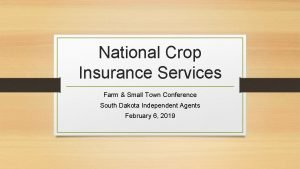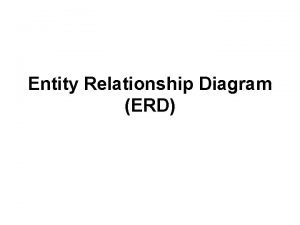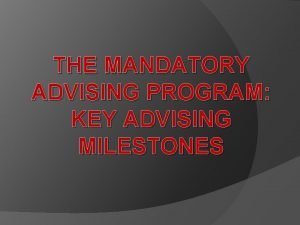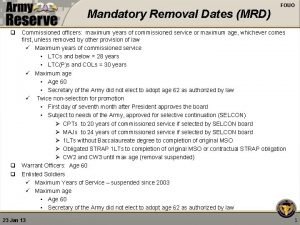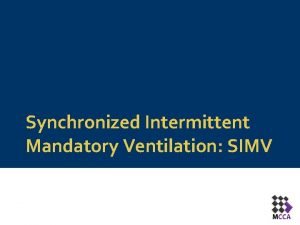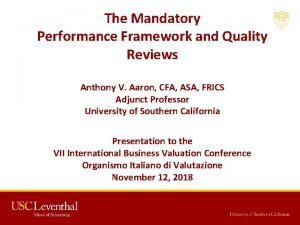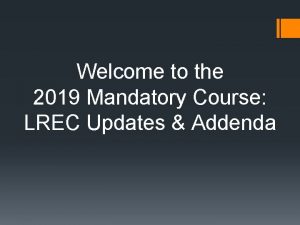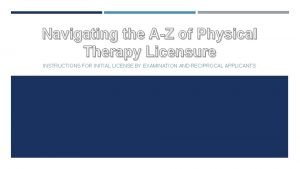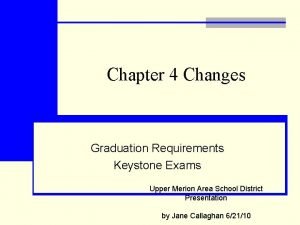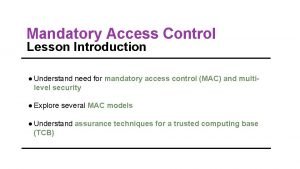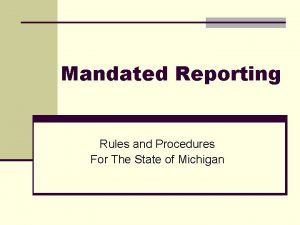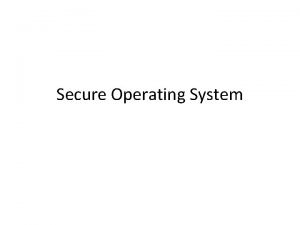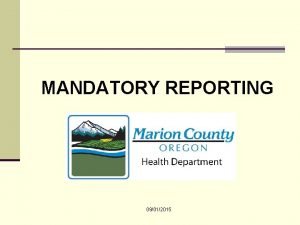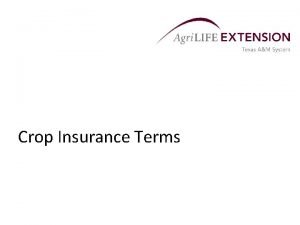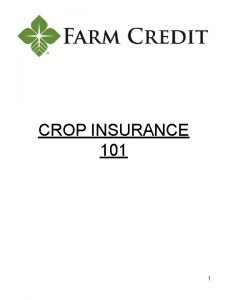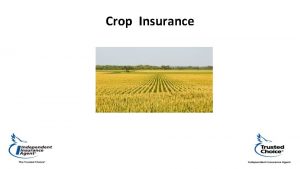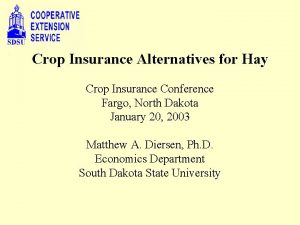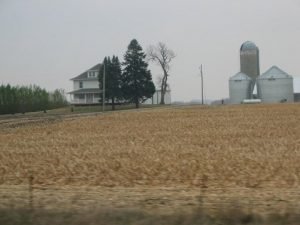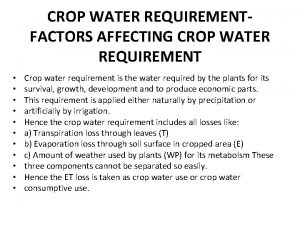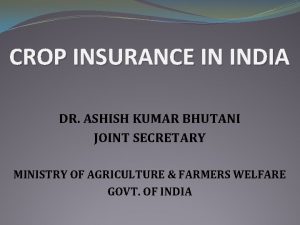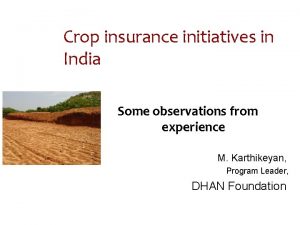24 th India Fellowship Seminar MANDATORY CROP INSURANCE


































- Slides: 34

24 th India Fellowship Seminar MANDATORY CROP INSURANCE & CHALLENGES Mentor - Mrs. Asha Joshi Presented by Prasunkumar Sarkar Ananthanarayanan C Anshul Bhushan 10 December 2015, Mumbai Indian Actuarial Profession Serving the Cause of Public Interest

Agenda • • Introduction Existing Mandatory Crop Insurance schemes Challenges (Pricing/Regulatory/Operational) Mandatory Crop Insurance for all - Pros/Cons Way forward Silver Lining Questions References www. actuariesindia. org 2

What is Crop Insurance? Insurance for farmers against loss of their crop due to various insured perils www. actuariesindia. org 3

Key Stakeholders in Crop Insurance State Govt and Agencies Banks Crop Insurance Insurers www. actuariesindia. org Farmers 4

Engagement Levels • State Governments – Not much unless there is pressure due to drought or farmer suicides • Banks – More interested in disbursing loans; would prefer to lend under other means • Insurers – Yes but severely constrained and heavily dependent on other stakeholders • Farmers – Very low unless impending disaster is very certain www. actuariesindia. org 5

History of Crop Insurance in India • In existence since the past three decades • Each successive scheme tried to improve on the previous schemes’ shortcomings • Major schemes introduced by the Government of India • CCIS (Comprehensive Crop Insurance Scheme) - 1985 • NAIS (National Agricultural Insurance Scheme) - 1999 • MNAIS (Modified NAIS) - 2010 • WBCIS (Weather Based Crop Insurance Scheme) 2007 • NCIP (National Crop Insurance Programme) - 2013 www. actuariesindia. org 6

CCIS - Introduction • Comprehensive Crop Insurance Scheme introduced in 1985 • Operated for almost a decade and a half • Scheme covered cereals, pulses and oilseeds • States were free to choose whether to implement it or not • CCIS compulsory for farmers taking loans for crops production • Farmer insured for 100% of the loan • Premiums and claim amounts shared by Central and State govt. in the ratio of 2: 1 • Uniform premium rate for the whole country based on crop • 50% subsidy for small and marginal farmers www. actuariesindia. org 7

CCIS – How did it work and why it failed? • Based on an area approach • Defined area could be a district, a block or any other contiguous area CCIS Performance during 1985 -1998* No. of farmers covered (Cr. ) Area covered (Cr. Ha. ) Sum insured (Cr. Rs. ) Premiums (Cr. Rs. ) Claims Ratio Claims/SI 7. 6 12. 8 24, 975 404 2, 319 575% 9. 29% • CCIS discontinued due to its financial unviability *Figures obtained from ‘Report of the Committee to Review the Implementation of Crop Insurance Schemes in India’, Ministry of Agriculture, Government of India, May 2014 www. actuariesindia. org 8

NAIS – Improvements over CCIS • National Agricultural Insurance Scheme (NAIS) introduced in 1999 • Scheme covered all crops where adequate yield data is available • Farmer loan up to 150% of the value of average yield • Improved pricing • Premium rates differs by crop and season for all crops other than annual commercial/horticultural crops • Annual commercial/horticultural crops – Premium based on experience www. actuariesindia. org 9

NAIS – Performance NAIS Performance during 1999 -2012* No. of farmers covered (Cr. ) Area covered (Cr. Ha. ) Sum insured (Cr. Rs. ) Premiums (Cr. Rs. ) Claims Ratio Claims/SI 20. 37 30. 7 2, 83, 720 8, 458 27, 962 331% 9. 9% • NAIS discontinued due to its financial unviability • Area unit size not small enough leading to heterogeneity in experience • MNAIS introduced to address shortcomings *Figures obtained from ‘Report of the Committee to Review the Implementation of Crop Insurance Schemes in India’, Ministry of Agriculture, Government of India, May 2014 www. actuariesindia. org 10

MNAIS – Improvements/Performance • Modified NAIS introduced (MNAIS) as a pilot scheme in 2010 • Improvements over NAIS • Actual premium charged – subsidy up to 75% • Premiums subsidy shared equally by Centre and State • Claim liability on the insurance company • Smaller unit of area (Village/Village panchayat) MNAIS Performance during 2010 -2013* No. of farmers insured (Cr. ) Area insured (Cr. Ha. ) Sum insured (Cr. Rs. ) 0. 46 0. 47 11, 024 Premiums Claims (Cr. Rs. ) 1, 088 864 Claims Ratio Claims/SI 79. 4% 7. 8% • MNAIS financials significantly better than CCIS and NAIS *Figures obtained from ‘Report of the Committee to Review the Implementation of Crop Insurance Schemes in India’, Ministry of Agriculture, Government of India, May 2014 www. actuariesindia. org 11

WBCIS – Introduction/Performance • Weather Based Crop Insurance Scheme (WBCIS) introduced in 2007 • Alternative to yield based insurance • Protection against crop losses resulting from adverse weather conditions (rain/temperature/humidity, etc. ) • Based on an area approach • Actuarial rates – capped at different levels for difference crops WBCIS Performance during 2007 -2013* No. of farmers insured (Cr. ) Area insured (Cr. Ha. ) Sum insured (Cr. Rs. ) Premiums (Cr. Rs. ) Claims Ratio Claims/SI 4. 69 6. 32 80, 951 7, 519 5, 286 70. 3% 6. 5% *Figures obtained from ‘Report of the Committee to Review the Implementation of Crop Insurance Schemes in India’, Ministry of Agriculture, Government of India, May 2014 www. actuariesindia. org 12

NCIP • National Crop Insurance Programme (NCIP) introduced in 2013 • Essentially merged the two major schemes - MNAIS and WBCIS • Encouragement from Govt. to implement MNAIS at village/panchayat level • Larger area for initial few years subject to approval • States implementing village/panchayat level to be reimbursed CCE expenses up to a limit • Aims to improve weather data for WBCIS • 5000 AWS (Automatic Weather Stations) to be set up through PPP model www. actuariesindia. org 13

Pricing Challenges- Weather Based Crop Insurance Scheme (WBCIS) • Absence of rigorous statistical analysis to choose the best index in a specific environment i. e. establishing correlation between the index parameters and the actual yields. • Pricing established through iterations so far in India. Perils not captured by the weather station data, such as localized weather, pestilence or disease, or weather events not adequately captured by the index used in the WBCIS product. Ideally WBCIS suited to cover CAT risks. WBCIS claim payments are expected to correlate more closely with area average yields than individual farmer yields. Standalone Pricing against Portfolio pricing • Oversensitive to statistically insignificant features of historical data • Data uncertainty more in historical data for a particular product • Cost of capital does not account diversification. A typical Weather Station in RUA • Remote sensing technology ( Satellite based Optical sensing to supplement WS data) • Insured’s choice of WS. • Reference of more than a single WS • More WS across the country. Moral Hazard and Adverse Selection www. actuariesindia. org 14

Pricing Challenges- Weather Based Index Insurance Example: Weather Based Crop Insurance Scheme (WBCIS) in India (Clarke et al, 2012) www. actuariesindia. org 15

Pricing Challenges- Weather Based Index Insurance (Contd. ) Example: Weather Based Crop Insurance Scheme (WBCIS) in India 9 years of data (1999 – 2007) (Clarke et al, 2012) www. actuariesindia. org 16

Pricing Challenges - Yield Index Based ( NAIS and MNAIS) In the present system district averages through crop cutting experiments do not capture the systemic risks at a smaller unit. High Basis Risk- Geographic Risk, Risk Coverage, Product Design De-trending of historical yields. • Identification of pure random improvements against technological improvements in yields. A typical crop cutting experiment • Reliability of Historical Data • Tendency to report lower yields especially in low yield scenarios. • Yield reporting is more reliable in good days i. e. high actual yields • • Moral Hazard and Adverse Selection • • A national Procedure Manuals for CCE’sclarifying the reasons for the yield losses so as to exclude yield losses attributable to non insured perils. CCE’s to be conducted by trained loss adjustors. Video recording of the official CCE’s. IU size could be reduced in areas with heterogeneous yields and increased in those areas with homogeneous yields. Real time reporting of CCEs by requiring primary workers to send yield data by mobile phone Independent, random CCE audit. Weather data, satellite images/ remote sensing technology to target CCEs in areas where claim payouts are high. • Delay in loss intimation, Delay in Final Settlement. • Challenges from a reserving perspective also. www. actuariesindia. org 17

Market Structure Challenges Any mandatory nature of insurance will reduce the incentives to design simple and transparent products. And this is complemented by the role of states in selecting the insurers. Market Structure • Multiple-year contract with a firm to design weather products across the state; and second, insurers could compete on price or other specified dimensions to offer the stated products. • States could tender for multi -year contracts with an insurance provider to design and offer products. • Regulation may impose a mandatory ten year history of claims that would have been paid , using data from the contractual weather station. ( If WS not available, then nearest government approved WS can be used). This would give indication to loanee as well as non-loanee farmers for understanding the effectiveness of the product. ( especially claims payments in bad years) ( F & U guidelines) Less innovation in product design following the introduction of WBCIS, despite the large amount of data available. This may be caused by an increase in competition having reduced the private benefits from designing improved indices. Decisions about weather indexed insurance products are complex and there is a strong rationale for creating a technical support unit to support central and state governments in making informed decisions about insurance product design, and in choosing between insurance providers. Contracts are therefore typically complex and a farmer is unlikely to even have a good idea about what the claim payments from the product would have been in the recent past. Poor understanding is particularly detrimental to farmers who are eligible but not compelled to purchase WBCIS insurance. www. actuariesindia. org 18

Market Structure Challenges (Cont. ) Institutional Mechanism – Absence of a Crop Insurance Legislation/Regulation to an Institutional Model promoting growth of the sector… e. g. • • • Number of weather stations and CCE’s to accurately represent risk. How to make rates in absence of data. More transparency in past claims settlements. Checking the authenticity and validation of WS data. Allowing the insured’ choice of WS as per the location of his/her field. National System for ongoing training of specialized personnel tasked with conducting Overseeing the process of CCEs for insurance purposes. CCEs to be conducted by trained loss adjustors in areas where large claims are expected due to observable adverse agricultural conditions. Supervisory role for loss adjustors in other areas. Independent, random CCE audit. Video recording of the official CCEs. www. actuariesindia. org • Widen the scope of the existing regulations in the short run • An all encompassing legislation on agriculture risk protection in the long run 19

Legislative Framework - Challenges No risk to be assumed unless premium is received in advance Refund of Premium: Section 64 VB. (3) of the Act states that “Any refund of premium which may become due to an insured on account of the cancellation of a policy or alteration in its terms and conditions or otherwise shall be paid by the insurer directly to the insured. Section 64 VB in the The Insurance Act 1938; Section 14(a) and (b) of the Act; Register of policies and register of claims: Section 14 (a) and (b) of the Act mentions that every insurer shall maintain a register or record of policies, in which shall be entered, in respect of every policy issued by the insurer, the name and address of the policy-holder. Policyholders Protection Act, 2002; Licensing of Corporate Agents, 2002 Loss Intimation Interest Payment on Delay in Claims Settlement Elaborate Training Requirements for licensing of individual/corporate insurance agents www. actuariesindia. org 20

Basic Principles of Insurance – Conflicts Applied to index insurance primarily. . Principle of Indemnity: Insurance is a contract of indemnity. Under such contracts, the insurer promises to indemnify the insured against any loss caused by the occurrence of the insured event. In other words, the insurer has to compensate the insured only for the actual loss that was sustained. (i) Index based claim payment: Under index insurance, payment is based on an index, not on actual loss. The index is only a proxy for the loss and may not ideally reflect the exact loss suffered by the farmer. (ii) Excess/Low Claims in relation to losses: The indemnity concept can also be construed as requiring that the insurance contracts cannot exceed Loss. Given the potential for basis risk, payment may exceed or may be lesser than the loss sustained by the insured. www. actuariesindia. org 21

Key Challenges or Hurdles • Insurance knowledge of farmers • • Poor awareness of farmers about crop insurance Not aware of various schemes how premium is deducted from loan amounts Not certain about sum insured • But some farmers who are aware do • Anti select based by delaying the insurance purchase • Cultivate a crop different from that being insured www. actuariesindia. org 22

Key Challenges or Hurdles • Crop Area Insured • Insured area is greater than sown area • Sometimes, there is no cultivation at all !! • Farmers insure the same area multiple times with different banks • Genuine cases do exist due to non germination of seeds • This leads to area correction factor (actual to insured) • But this is applied to the entire state • Impacts honest farmers too www. actuariesindia. org 23

Key Challenges or Hurdles • Crop loan practices • Banks do not confirm to principles and guidelines of crop insurance schemes • Kharif season – more loans disbursed; Rabi season – less loans disbursed • Disburse loans after cut off date to evade premium • Unusual high loans disbursed towards the cut off dates when there is more certainty about weather conditions www. actuariesindia. org 24

Key Challenges or Hurdles • Weather Data • Lack of confidence in AWS which forms the basis for determination of claims in WBCIS • AWS density is not sufficient to gather credible data • Delay in sending weather data by private agencies • Inherent variation in weather data between two places 20 kms adds to the issue • Relation of weather parameters to claims is not understood by the farmer www. actuariesindia. org 25

Key Challenges or Hurdles • Crop Cutting Experiments (CCE) • Inherently a difficult task – number of CCE, spread of area over which to perform and short time span • Reliability of data collected – procedure not properly followed, local pressure to underestimate the yield • Delay in consolidation of data • Lack of trained people to conduct the CCE www. actuariesindia. org 26

Key Challenges or Hurdles • Settlement of Claims • If claims are not settled in a timely manner, then the credibility of the crop insurance scheme is damaged • Impacted by the multiple stakeholder set up • CCE data sometimes takes months to be collated and sent to the nodal agencies • Premium or part of it is not received by the insurer for months (for example the subsidy component from state government) www. actuariesindia. org 27

Other Challenges or Hurdles • Allocation of Districts to Insurers • Insurance Premium • Technical Skill building • Product Design www. actuariesindia. org 28

Crop Insurance compulsory for all? • Pros • Everyone covered following a calamity • Govt. may invest in flood defences, irrigation, etc so that areas are insurable • There is a wider pool from which risks can be pooled • Mitigates adverse selection which is an area of concern • Would help in understanding risks better and better pricing & risk management • Cons • Farmers may not be able to afford • Administratively difficult to implement given the existing challenges • May not be a popular move for the govt. (to force everyone purchasing insurance) • Need a robust regulatory structure which is currently missing www. actuariesindia. org 29

Way forward • Use of Technology at various stages • Technology can be helpful to reduce the time taken to collect, collate data, reconcile data • Loan Disbursal Stage – Use of land records from digital database • Crop Cutting Experiments – Using remote sensing methods • Weather data information in real time www. actuariesindia. org 30

Way forward • Allocation of district for a longer tenure • Districts may be allocated to insurer(s) for a longer tenure – say five years • It would reduce the uncertainty that the insurers currently face between two successive years • It would help develop better pricing basis in premiums • It would reduce the volatility in results year on year – since experience rating can be incorporated in pricing • Goodwill generated when claims are settled is not lost when the insurer is no longer associated with the area www. actuariesindia. org 31

Silver Lining • Though we have addressed issues in crop insurance, it does not imply all is wrong with it • Some positives from crop insurance • It has indemnified farmers in times of adversity • Awareness of crop insurance is gradually increasing • It has given insurance companies scope to diversify their product portfolio • More focus on crop and its associated risks has also brought multi stakeholders together & sharing knowledge www. actuariesindia. org 32

Questions? www. actuariesindia. org 33

References • ‘Report of the Committee to Review the Implementation of Crop Insurance Schemes in India’, Ministry of Agriculture, Government of India, May 2014 • ‘Policy Research Working Paper on WBCIS’ by World Bank, 2012 • ‘Crop Insurance Seminar’ by IAI in 2013 • ‘Crop Insurance Seminar’ by IAI in 2014 • ‘Policy Research Working Paper on MNAIS’ by World Bank, 2012 www. actuariesindia. org 34
 National crop insurance services
National crop insurance services Crop insurance yield descriptors
Crop insurance yield descriptors Houston marine insurance seminar
Houston marine insurance seminar Seminar on education in india
Seminar on education in india Insurance proposals fire insurance
Insurance proposals fire insurance Insurance valuer course in india
Insurance valuer course in india Mandatory declassification review
Mandatory declassification review Mandatory meeting notice
Mandatory meeting notice Normal bruising areas on a child
Normal bruising areas on a child Mandatory training definition
Mandatory training definition Erd plus
Erd plus Mandatory kpps
Mandatory kpps Vytautas šenavičius
Vytautas šenavičius Mandatory
Mandatory Mandatory html tags
Mandatory html tags Ideally an entity identifier is composed of
Ideally an entity identifier is composed of South tees mandatory training
South tees mandatory training Mandatory spending
Mandatory spending Mandated reporter alabama
Mandated reporter alabama Mandatory removal date army regulation
Mandatory removal date army regulation Synchronized intermittent mandatory ventilation
Synchronized intermittent mandatory ventilation Ceiv credential
Ceiv credential Lrec purchase agreement
Lrec purchase agreement Tn mandatory reporting laws
Tn mandatory reporting laws Mandatory ang
Mandatory ang Mandatory practitioner profile questionnaire
Mandatory practitioner profile questionnaire Lucien febvre possibilism
Lucien febvre possibilism Standardisation versus adaptation
Standardisation versus adaptation Are the keystone exams mandatory
Are the keystone exams mandatory Mandatory photo spot
Mandatory photo spot Bgp well known mandatory attributes
Bgp well known mandatory attributes Which elements are mandatory in an xhtml document
Which elements are mandatory in an xhtml document Mandatory access control (mac)
Mandatory access control (mac) Who is a mandatory reporter
Who is a mandatory reporter Mandatory protection system
Mandatory protection system
